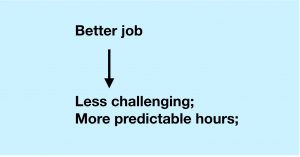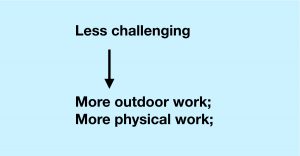Downward laddering is useful for systematically unpacking what people mean by technical terms and subjective terms.
Strengths of this method:


Choose a term as your starting point.
This will usually be a technical or a subjective term that the participant used in a previous session of observation, card sorts, or think-aloud.

Ask the participant ‘How can you tell that something is X?’
Tip: If they start giving a long explanation, ask them to slow down, and make it clear that you’re going to write down their exact words.

Step 3: Record their answer verbatim, using their exact words.
The picture below shows how this is recorded.

The term used as a starting point is Better job.
The downward-pointing arrow beneath it is the laddering notation for ‘How can you tell that something is a better job?’
The two items below the arrow are the participant’s response, with each item on a separate line, ending in a semi-colon to show where each item ends (some items might need several lines).

Repeat the process for each item in the response, in turn.
In this example, you would begin by asking how they could tell that a job was less challenging, as shown below. After that, you would ask how they could tell that a job had more predictable hours.

Ideally, you would unpack everything in turn. In reality, this could take hours, so you’ll have to make judgment calls about what to unpack.
Tip: Never assume that the answer is obvious; a key strength of this method is that it finds unexpected results, as in the example above, where many people would think that more physical work would be more challenging, rather than less challenging.

Repeat the process until you reach one of the following types of response:
Tip: Don’t stop before this point; usually the most powerful insights come at this stage, when you discover that the person is using a term in a totally unexpected way.
Tip: Always start each chain as a new fresh diagram; if you try to fit more than one chain into a diagram, it quickly becomes unmanageable.

You can analyse the results in various ways, including:
